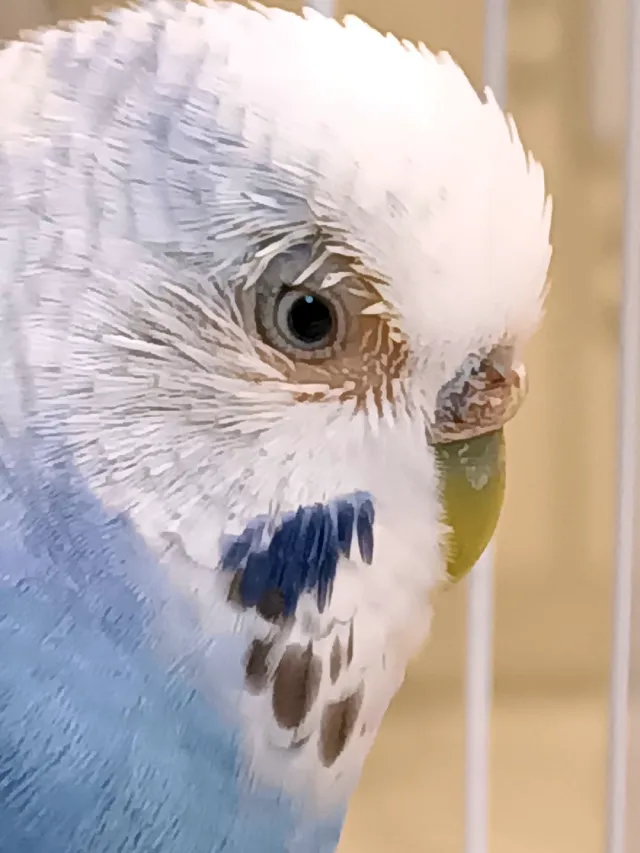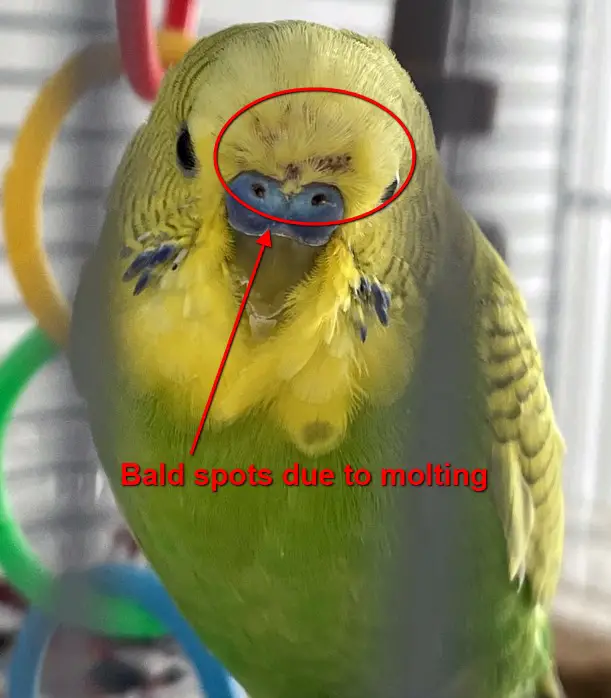Bald spots on your budgie can result from various factors such as molting, feather mites, injury, feather plucking, malnutrition, illness and infections, hormonal changes, allergies, fungal infections, psittacine beak and feather disease, dermatitis, feather cysts, feather picking by cage mates, ectoparasites, or vitamin deficiencies.
Budgie owners and bird enthusiasts, this is for you.
If you’re witnessing your budgie with bald spots and seeking answers, this guide was crafted just for you.
Drawing from my own experiences, vast readings, and observations from various resources, I decided to compile a comprehensive rundown on the possible causes of this issue.
With ‘Why Does My Budgie Have Bald Spots? All Possible Causes’, expect to gain a clearer understanding of what’s happening to your feathered friend.

What Causes Bald Spots In Budgies?
When we observe bald spots on our budgies, our minds may spiral into a flurry of worrying questions.
Rest assured, understanding the root of the problem is a significant first step.
The causes can range from natural processes to pests, physical harm, and even psychological issues.
Molting
To start with, molting is a process that might be behind the bald spots you notice on your budgie.

Now, what is budgie molting? It’s a completely natural and healthy process where budgies shed their old feathers to make way for new ones.
Think of it as a bird’s way of refreshing its wardrobe! This cycle typically happens a couple of times a year.
During this phase, you might notice some small bald spots appearing on your budgie’s body.
But fear not, these patches are simply the places where new feathers are set to sprout.
It’s their body preparing a canvas for new growth, if you will.
Though it might look a little disconcerting initially, you’ll soon see new feathers coming in, adding to your budgie’s colorful charm.
Feather Mites
On a less pleasant note, an infestation of feather mites could be causing bald patches on your budgie.
These minute creatures are parasitic, meaning they live off your budgie, causing discomfort and potentially damaging their feathers.
The feather mites inhabit the feathers and skin of your budgie, and their activity can lead to itching and irritation.
As a result, the budgie may excessively preen or scratch, leading to feather loss and, consequently, bald patches.
While a healthy bird can keep mite populations under control, factors like stress, illness, or poor diet can give the mites an upper hand.
So, spotting bald patches could indicate a feather mite issue that needs addressing.
Injury
Another cause for concern could be physical injury.
Budgies are active birds, fond of flying, exploring, and playing.
However, this zest for life might occasionally lead to bumps, falls, or collisions.
Just as we might sustain bruises or scrapes, budgies can also suffer from physical traumas.
An injury might cause feather loss at the site of the trauma, which would appear as a bald spot.
Such injuries can also occur due to aggressive interactions with other birds, especially in overcrowded conditions.
Thus, keeping a keen eye on your budgie’s activities and interactions can help prevent such incidents.
In each of these scenarios, it’s crucial to understand that these are not mere superficial issues.
Bald spots on your budgie could indicate underlying problems needing attention.
Feather Picking By Cage Mates
An often-overlooked cause of baldness in budgies can be attributed to feather picking by cage mates.
This behavior can occur due to various reasons, from dominance displays to a simple lack of space.
It is essential to monitor your budgies’ interactions and ensure they have enough room to prevent this behavior.
Feather Plucking
The sight of your budgie constantly grooming itself might initially appear as a display of self-care, but when it leads to feather plucking, it’s indicative of a larger problem.
Budgies may pluck their feathers due to stress, anxiety, or even boredom.
This behavior can also stem from a myriad of health issues, ranging from skin irritations to internal diseases.
Excessive preening, chewing, and feather plucking are signs of distress.
The repeated pulling of feathers could eventually lead to bald spots.
Furthermore, once a budgie starts plucking its feathers, it can develop into a hard-to-break habit, sometimes fueled by the fact that growing feathers can be itchy, encouraging more plucking.
Malnutrition
The old adage, “You are what you eat,” applies not just to us but to our budgies as well.
Malnutrition, particularly a diet deficient in essential nutrients, can adversely affect your budgie’s feather health.
This dietary imbalance can lead to feather loss, resulting in the bald patches that worry you.
Budgies require a balanced diet rich in proteins, vitamins, and minerals for maintaining healthy feathers.
A diet based solely on seeds will not meet these needs.
For optimal health, budgies should be offered a variety of foods, including high-quality pellet food, fresh fruits, and vegetables.
Illness and Infections
Various illnesses and infections can lead to feather loss and, consequently, bald spots in budgies.
These ailments can include bacterial, viral, or fungal infections that affect the skin, feathers, or overall health of the bird.
For instance, a skin infection might cause itching, leading to excessive scratching and subsequent feather loss.
Systemic illnesses, on the other hand, could lead to poor feather health, making them brittle and prone to falling out.
Even metabolic diseases like liver dysfunction can impact feather growth, as the liver plays a key role in protein synthesis, essential for healthy feathers.
When bald spots are accompanied by other signs of illness, such as lethargy, changes in eating or drinking habits, or changes in droppings, it’s time to consult a vet.
Hormonal Changes
The intricate dance of hormonal changes in budgies can have a variety of impacts, one of them being feather loss.
Especially during the breeding season, a budgie might experience a significant shift in its hormone levels.
This hormonal imbalance can affect feather growth and might even lead to the appearance of temporary bald spots.
While it’s essential to remember that temporary baldness due to hormonal changes is natural and expected, persistent bald spots or extreme feather loss could signal a more serious hormonal imbalance.
Allergies
Did you know budgies could have allergies too? Just like us, budgies can develop allergies to certain foods, substances, or environmental factors.
The allergic reactions may manifest as skin irritations and inflammation, and these could result in feather loss and bald spots.
Budgies might be allergic to things in their environment such as certain types of bedding, aerosols, or even cigarette smoke.
Alternatively, a food allergy could be at fault.
Watching for signs of discomfort in your budgie following exposure to new substances or foods can help identify potential allergens.
Once the allergen is removed, the feather loss should resolve itself.
Fungal Infections
In the world of budgies, fungal infections such as aspergillosis can be a hidden enemy.
These infections can target your budgie’s feathers and skin, leading to discomfort, feather loss, and the appearance of bald spots.
The fungus thrives in environments that are warm, damp, and poorly ventilated, turning a seemingly harmless cage into a potential petri dish of trouble for your feathery friend.
Fungal infections can cause not only visible changes, such as bald spots but can also affect your budgie’s overall health.
Watching out for other symptoms like changes in behavior, loss of appetite, or difficulty breathing can help in early detection and treatment of these infections.
Psittacine Beak And Feather Disease (PBFD)
One of the most significant health threats to parrots, including budgies, is Psittacine Beak and Feather Disease (PBFD).
This viral disease doesn’t just stop at causing feather abnormalities and bald spots.
It also brings along with it beak deformities and immune system suppression, making it a severe health concern for your budgie.
PBFD is highly contagious and can be fatal, so immediate medical attention is necessary if you suspect your bird has contracted it.
As always, prevention is better than cure, and ensuring a clean, stress-free environment for your bird can go a long way in preventing such diseases.
Dermatitis
Dermatitis, an inflammation of the skin, can also cause bald spots in budgies.
This condition can be brought on by many factors, such as poor hygiene, irritants in the environment, or even an allergic reaction.
Budgies with dermatitis might exhibit itchy, red, and swollen skin, and may pluck at their feathers due to discomfort, leading to bald spots.
Feather Cysts
Feather cysts are another potential cause of bald spots in budgies.
These occur when a new feather can’t break through the skin and instead grows inward, forming a cyst.
This can cause a budgie to lose feathers around the area of the cyst and, if not treated promptly, can lead to infection and further feather loss.
Ectoparasites
Ectoparasites, such as mites and lice, can be an uncomfortable experience for your budgie and a potential cause of bald spots.
These tiny creatures can cause your budgie to itch and scratch, leading to feather loss.
Vitamin Deficiencies
A proper diet is crucial to the health of your budgie.
Vitamin deficiencies, particularly a lack of vitamin A or B, can lead to poor feather health and potentially result in bald spots.
Faqs
Can Environment Contribute to Bald Spots in Budgies?
Absolutely.
Environmental factors can play a significant role in causing bald spots in budgies.
Poor hygiene or lack of cleanliness can lead to a build-up of pathogens or parasites in the bird’s environment, which might result in infections causing feather loss.
Furthermore, an unsuitable or stress-inducing environment can trigger behavioral issues such as feather plucking in budgies, leading to bald patches.
How Does a Budgie’s Diet Impact Feather Health?
Budgies require a balanced diet rich in essential nutrients for maintaining optimal health, including feather health.
Inadequate nutrition, such as a diet lacking in essential vitamins, minerals, and proteins, can negatively impact a budgie’s feather health and growth, potentially leading to feather loss or bald spots.
Is There a Connection Between a Budgie’s Behavior and Bald Spots?
Yes, a budgie’s behavior can be directly linked to the presence of bald spots.
Stress, anxiety, or boredom may prompt behaviors like feather plucking, or overpreening, all of which can result in bald patches.
Recognizing and addressing behavioral issues promptly is crucial for preventing unnecessary feather loss.
Can a Budgie’s Age Influence the Occurrence of Bald Spots?
While age itself might not directly cause bald spots, older budgies may be more susceptible to health conditions that result in feather loss.
Hormonal changes, reduced immunity, and age-related diseases can all contribute to feather abnormalities, including bald spots.
It’s vital to ensure regular vet check-ups for older budgies to monitor their health closely.
Is Baldness in Budgies a Sign of a Serious Health Issue?
Baldness in budgies can sometimes indicate serious health issues, such as infections, parasitic infestations, or diseases like Psittacine Beak and Feather Disease (PBFD).
If a budgie develops bald spots, especially if accompanied by other symptoms, it’s important to consult with a vet as soon as possible for appropriate diagnosis and treatment.
